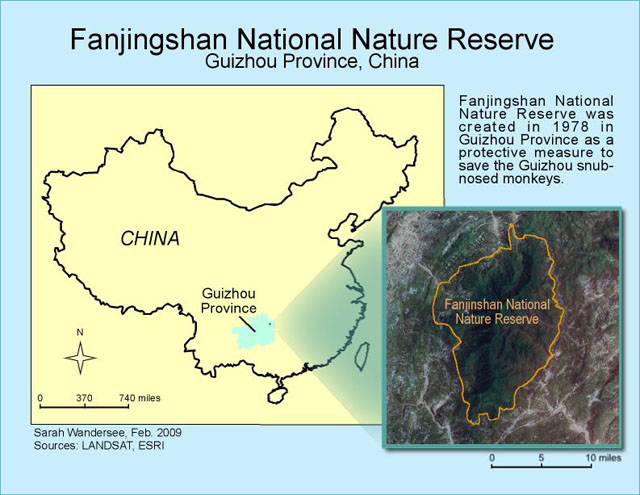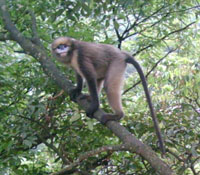Project Details
Background
The study of illegal mining effects on golden monkey habitat focuses on the convergence of two contemporary environmental issues—biodiversity loss and mining impacts. Biodiversity loss is a major environmental concern in contemporary society and science. Although extinction has occurred in the past, the current rate of loss is 100-1,000 times higher than before human activity effects (Chapin III, Zavaleta, Valerie, Naylor, Vitousek, Reynolds et al., 2000). Furthermore, despite extensive studies, biodiversity itself is still not completely understood (Gaston, 1996). However, due to the irrevocable nature of biodiversity loss, there was never a greater need for this understanding of its effects and dynamics than now. More controversial, the issue of mining incites heated debate among environmentalists, sociologists, and developers, due to the trade-off between environmental impacts, livelihood effects, need for metals, and profit (Bebbington et al., 2008; Bury, 2005; Nash, 1993). Mining impacts have also received more attention of late as the environmental effects of mine waste and acid mine drainage have been publicized and have become better documented and understood, using both on-site chemical analyses and remote sensing (Limpitlaw, 2002; Rigina, 2002; Manu 2004; Limpitlaw & Woldai, 2004). This study will contribute to both discourses by furthering knowledge of an endangered species (Rhinopithecus brelichi) and the impacts of illegal mining on its habitat in Fanjinshan National Nature Reserve, China.
Study Area
 Fanjingshan National Nature Reserve (FNNR), approximately 160 square miles in area (Bleisch et al., 1993), is located in Guizhou province, southwestern China. FNNR contains the only populations of the Guizhou golden snub-nosed monkey (700-800 animals in total; Rhinopithecus brelichi), one of four species of snub-nosed monkey in the world, of which three are endemic to China (Li et al., 2002). FNNR is within one of the 25 global biodiversity hotspots identified by Myers et al. (2000), with over 3, 000 animal, plant, and insect species (Yang et al. 2002, pp. 17). Human activity is not limited to areas outside the reserve boundaries and has a local population of 21,000 local residents living within or near the boundary of the reserve. With human activity, such as tourism, growing in China’s nature reserves (Li & Han, 2001; Liu, 2003), it is important to document and analyze the impacts of activities in order to better understand their effects on the biodiversity in the reserve.
Fanjingshan National Nature Reserve (FNNR), approximately 160 square miles in area (Bleisch et al., 1993), is located in Guizhou province, southwestern China. FNNR contains the only populations of the Guizhou golden snub-nosed monkey (700-800 animals in total; Rhinopithecus brelichi), one of four species of snub-nosed monkey in the world, of which three are endemic to China (Li et al., 2002). FNNR is within one of the 25 global biodiversity hotspots identified by Myers et al. (2000), with over 3, 000 animal, plant, and insect species (Yang et al. 2002, pp. 17). Human activity is not limited to areas outside the reserve boundaries and has a local population of 21,000 local residents living within or near the boundary of the reserve. With human activity, such as tourism, growing in China’s nature reserves (Li & Han, 2001; Liu, 2003), it is important to document and analyze the impacts of activities in order to better understand their effects on the biodiversity in the reserve.
The Guizhou Golden Monkey
Primates all over the world are fighting for survival (International Union for Conservation of Nature and Natural Resources, 2008), with low population numbers battling against habitat development and degradation. The Guizhou golden snub-nosed monkey (Rhinopithecus brelichi) can only be found in Fanjingshan National Nature Reserve. China itself is the only place to find three of the four species of snub-nosed monkeys (Li, Pan, & Oxnard, 2001), which have seen a drastic reduction in range over the past 400 years (Li et al., 2001). Rumors of the Guizhou golden monkeys existed in the 1950s but were not justified until they were “rediscovered in the early 1960s by Chinese researchers” (Bleisch et al., 1993, p.73). Studies on the snub-nosed monkeys have been conducted (Li et al., 2001), and focused research on the Sichuan snub-nosed monkeys has brought much knowledge to the field (Tan, Guo, & Li, 2005). Still, the Guizhou golden monkey has yet to receive extensive in-depth research beyond one field study in 1991 (Bleisch et al., 1993), which focused more on population dynamics than on environmental threats.
Quick Monkey Facts
 Rhinopithecus brelichi
Rhinopithecus brelichi
Habitat: mixed evergreen and deciduous forest between 1500 and 2200 meters in elevation in Fanjingshan National Nature Reserve, China
Habitat Area: approximately 108 square miles
Movement: arboreal
Population: 700-800 individuals
Family Size: 5-10, 1 adult male
Diet: young leaves, flower and leaf buds, fruit, seeds, bark, insect larvae
Other: no seasonal elevation migration, temporary groups 400+, potentially 2 distinct bands, aggressive intergroup interaction
Bleisch et al., 1993
Picture courtesy of Dr. Li An, Golden Monkey Project
Research Question
The main research question for this study is: Where and why is illegal mining happening within Fanjingshan National Nature Reserve (FNNR), and what is the impact upon the golden monkey habitat use?
Objectives and Methods
Objective 1. Determine where the illegal mining activity is occurring: Land cover analysis using remote sensing imagery, Ground control point collection to increase accuracy, Ground truthing of suspected mining sites
Objective 2. Assess the extent to which illegal mining is affecting golden monkey habitat through deforestation: Potential monkey habitat identification, Ground truthing of habitat, Habitat deforestation analysis
Objective 3. Determine how illegal mining is affecting golden monkey habitat use through pollution and noise disturbance: Noise disturbance analysis using sound level meters, Water pollution survey
Objective 4. Examine the drivers of the illegal mining activity: Interviews, Livelihood Analysis